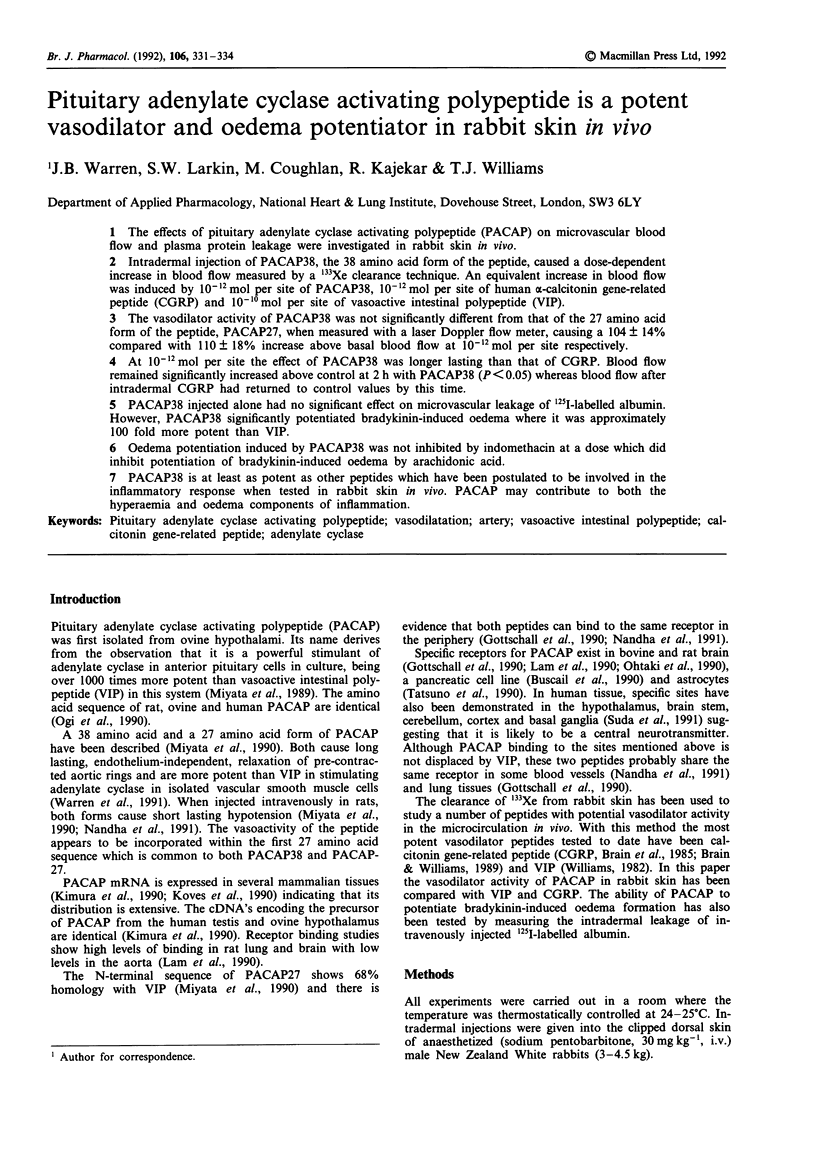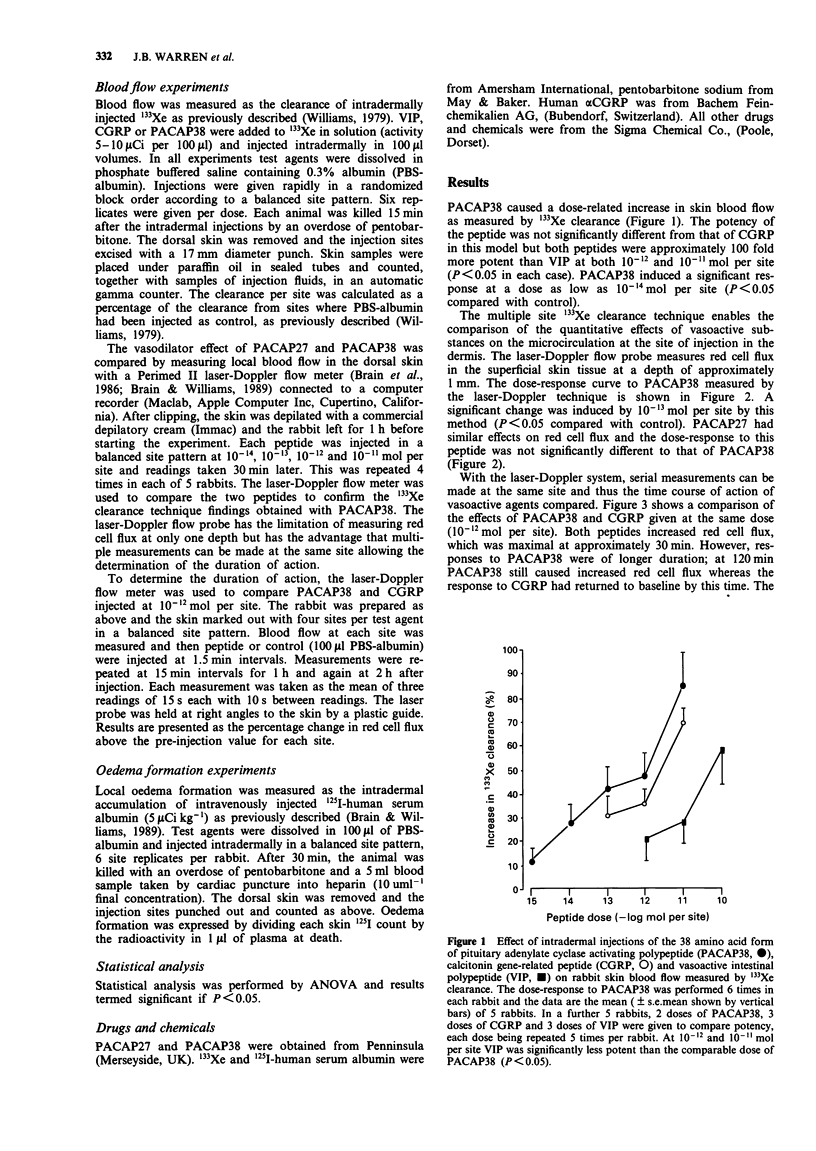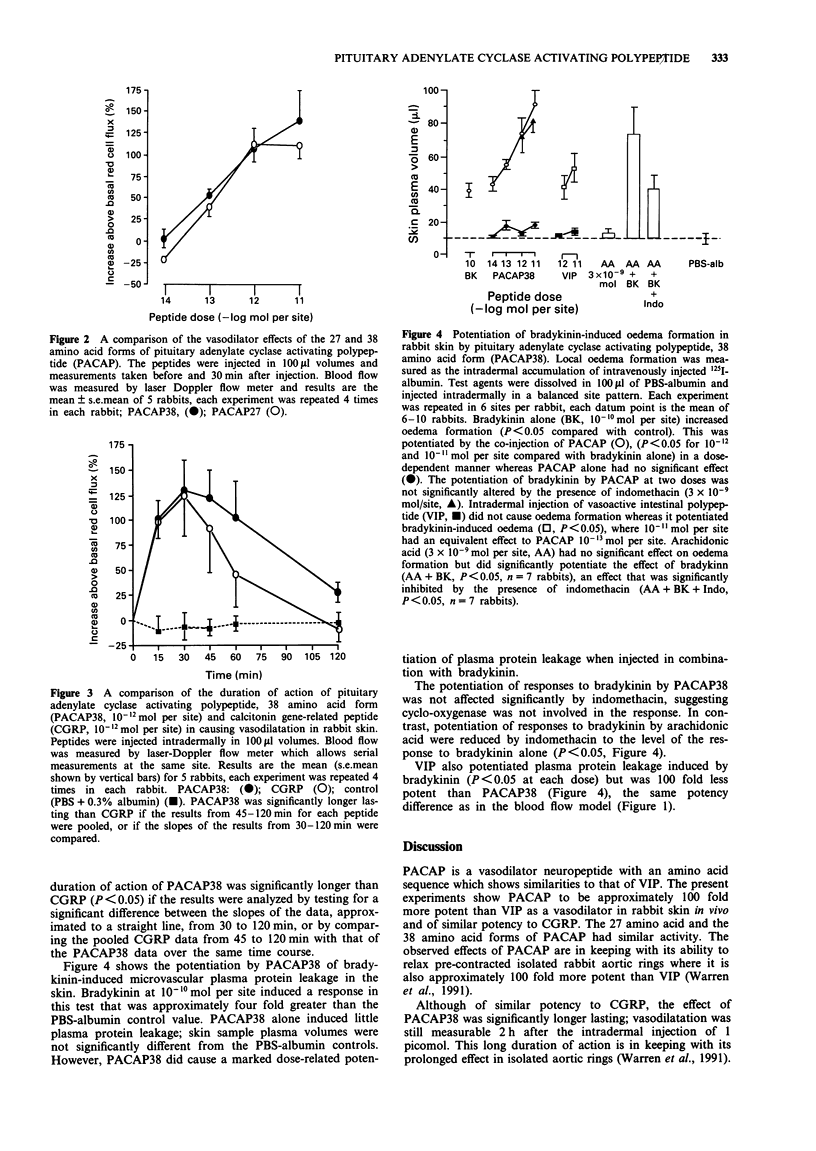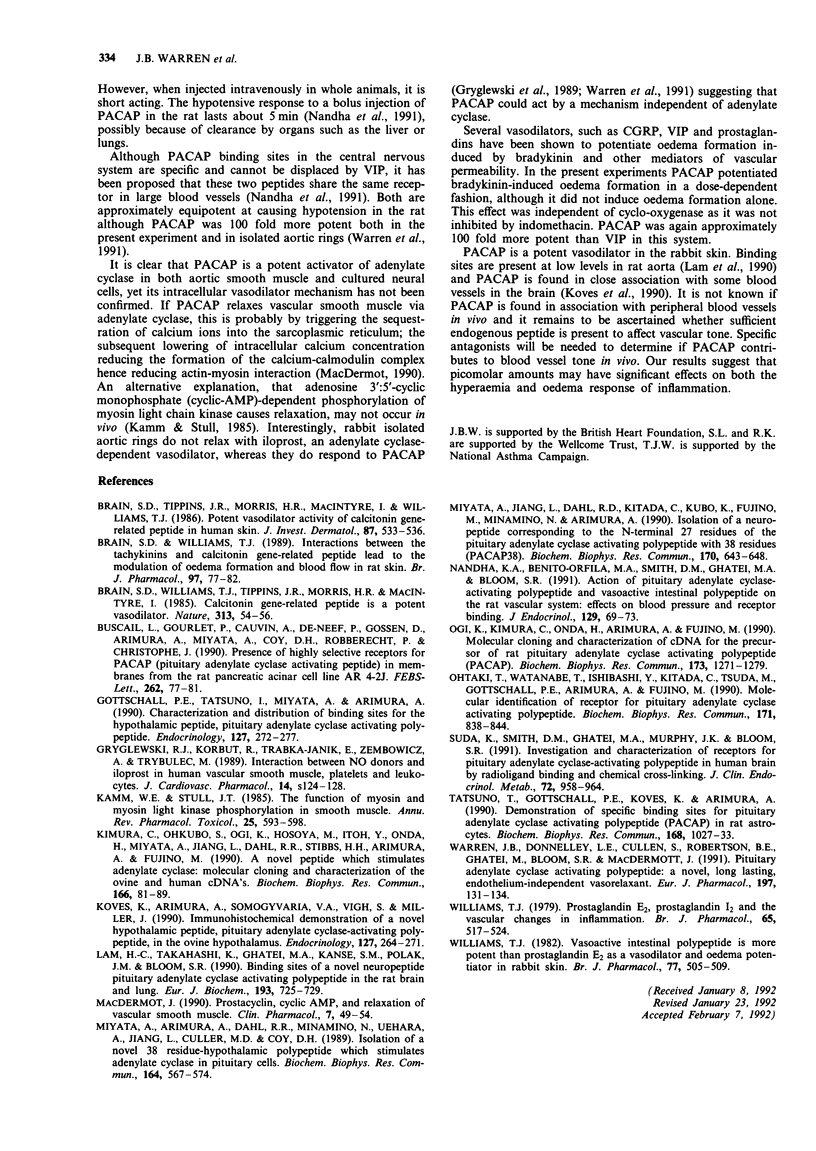Abstract
1. The effects of pituitary adenylate cyclase activating polypeptide (PACAP) on microvascular blood flow and plasma protein leakage were investigated in rabbit skin in vivo. 2. Intradermal injection of PACAP38, the 38 amino acid form of the peptide, caused a dose-dependent increase in blood flow measured by a 133Xe clearance technique. An equivalent increase in blood flow was induced by 10(-12) mol per site of PACAP38, 10(-12) mol per site of human alpha-calcitonin gene-related peptide (CGRP) and 10(-10) mol per site of vasoactive intestinal polypeptide (VIP). 3. The vasodilator activity of PACAP38 was not significantly different from that of the 27 amino acid form of the peptide, PACAP27, when measured with a laser Doppler flow meter, causing a 104 +/- 14% compared with 110 +/- 18% increase above basal blood flow at 10(-12) mol per site respectively. 4. At 10(-12) mol per site the effect of PACAP38 was longer lasting than that of CGRP. Blood flow remained significantly increased above control at 2 h with PACAP38 (P less than 0.05) whereas blood flow after intradermal CGRP had returned to control values by this time. 5. PACAP38 injected alone had no significant effect on microvascular leakage of 125I-labelled albumin. However, PACAP38 significantly potentiated bradykinin-induced oedema where it was approximately 100 fold more potent than VIP. 6. Oedema potentiation induced by PACAP38 was not inhibited by indomethacin at a dose which did inhibit potentiation of bradykinin-induced oedema by arachidonic acid.(ABSTRACT TRUNCATED AT 250 WORDS)
Full text
PDF



Selected References
These references are in PubMed. This may not be the complete list of references from this article.
- Brain S. D., Tippins J. R., Morris H. R., MacIntyre I., Williams T. J. Potent vasodilator activity of calcitonin gene-related peptide in human skin. J Invest Dermatol. 1986 Oct;87(4):533–536. doi: 10.1111/1523-1747.ep12455620. [DOI] [PubMed] [Google Scholar]
- Brain S. D., Williams T. J. Interactions between the tachykinins and calcitonin gene-related peptide lead to the modulation of oedema formation and blood flow in rat skin. Br J Pharmacol. 1989 May;97(1):77–82. doi: 10.1111/j.1476-5381.1989.tb11926.x. [DOI] [PMC free article] [PubMed] [Google Scholar]
- Brain S. D., Williams T. J., Tippins J. R., Morris H. R., MacIntyre I. Calcitonin gene-related peptide is a potent vasodilator. Nature. 1985 Jan 3;313(5997):54–56. doi: 10.1038/313054a0. [DOI] [PubMed] [Google Scholar]
- Buscail L., Gourlet P., Cauvin A., De Neef P., Gossen D., Arimura A., Miyata A., Coy D. H., Robberecht P., Christophe J. Presence of highly selective receptors for PACAP (pituitary adenylate cyclase activating peptide) in membranes from the rat pancreatic acinar cell line AR 4-2J. FEBS Lett. 1990 Mar 12;262(1):77–81. doi: 10.1016/0014-5793(90)80158-f. [DOI] [PubMed] [Google Scholar]
- Gottschall P. E., Tatsuno I., Miyata A., Arimura A. Characterization and distribution of binding sites for the hypothalamic peptide, pituitary adenylate cyclase-activating polypeptide. Endocrinology. 1990 Jul;127(1):272–277. doi: 10.1210/endo-127-1-272. [DOI] [PubMed] [Google Scholar]
- Gryglewski R. J., Korbut R., Trabka-Janik E., Zembowicz A., Trybulec M. Interaction between NO donors and iloprost in human vascular smooth muscle, platelets, and leukocytes. J Cardiovasc Pharmacol. 1989;14 (Suppl 11):S124–S128. [PubMed] [Google Scholar]
- Kamm K. E., Stull J. T. The function of myosin and myosin light chain kinase phosphorylation in smooth muscle. Annu Rev Pharmacol Toxicol. 1985;25:593–620. doi: 10.1146/annurev.pa.25.040185.003113. [DOI] [PubMed] [Google Scholar]
- Kimura C., Ohkubo S., Ogi K., Hosoya M., Itoh Y., Onda H., Miyata A., Jiang L., Dahl R. R., Stibbs H. H. A novel peptide which stimulates adenylate cyclase: molecular cloning and characterization of the ovine and human cDNAs. Biochem Biophys Res Commun. 1990 Jan 15;166(1):81–89. doi: 10.1016/0006-291x(90)91914-e. [DOI] [PubMed] [Google Scholar]
- Köves K., Arimura A., Somogyvári-Vigh A., Vigh S., Miller J. Immunohistochemical demonstration of a novel hypothalamic peptide, pituitary adenylate cyclase-activating polypeptide, in the ovine hypothalamus. Endocrinology. 1990 Jul;127(1):264–271. doi: 10.1210/endo-127-1-264. [DOI] [PubMed] [Google Scholar]
- Lam H. C., Takahashi K., Ghatei M. A., Kanse S. M., Polak J. M., Bloom S. R. Binding sites of a novel neuropeptide pituitary-adenylate-cyclase-activating polypeptide in the rat brain and lung. Eur J Biochem. 1990 Nov 13;193(3):725–729. doi: 10.1111/j.1432-1033.1990.tb19392.x. [DOI] [PubMed] [Google Scholar]
- Miyata A., Arimura A., Dahl R. R., Minamino N., Uehara A., Jiang L., Culler M. D., Coy D. H. Isolation of a novel 38 residue-hypothalamic polypeptide which stimulates adenylate cyclase in pituitary cells. Biochem Biophys Res Commun. 1989 Oct 16;164(1):567–574. doi: 10.1016/0006-291x(89)91757-9. [DOI] [PubMed] [Google Scholar]
- Miyata A., Jiang L., Dahl R. D., Kitada C., Kubo K., Fujino M., Minamino N., Arimura A. Isolation of a neuropeptide corresponding to the N-terminal 27 residues of the pituitary adenylate cyclase activating polypeptide with 38 residues (PACAP38). Biochem Biophys Res Commun. 1990 Jul 31;170(2):643–648. doi: 10.1016/0006-291x(90)92140-u. [DOI] [PubMed] [Google Scholar]
- Nandha K. A., Benito-Orfila M. A., Smith D. M., Ghatei M. A., Bloom S. R. Action of pituitary adenylate cyclase-activating polypeptide and vasoactive intestinal polypeptide on the rat vascular system: effects on blood pressure and receptor binding. J Endocrinol. 1991 Apr;129(1):69–73. doi: 10.1677/joe.0.1290069. [DOI] [PubMed] [Google Scholar]
- Ogi K., Kimura C., Onda H., Arimura A., Fujino M. Molecular cloning and characterization of cDNA for the precursor of rat pituitary adenylate cyclase activating polypeptide (PACAP). Biochem Biophys Res Commun. 1990 Dec 31;173(3):1271–1279. doi: 10.1016/s0006-291x(05)80924-6. [DOI] [PubMed] [Google Scholar]
- Ohtaki T., Watanabe T., Ishibashi Y., Kitada C., Tsuda M., Gottschall P. E., Arimura A., Fujino M. Molecular identification of receptor for pituitary adenylate cyclase activating polypeptide. Biochem Biophys Res Commun. 1990 Sep 14;171(2):838–844. doi: 10.1016/0006-291x(90)91222-e. [DOI] [PubMed] [Google Scholar]
- Suda K., Smith D. M., Ghatei M. A., Murphy J. K., Bloom S. R. Investigation and characterization of receptors for pituitary adenylate cyclase-activating polypeptide in human brain by radioligand binding and chemical cross-linking. J Clin Endocrinol Metab. 1991 May;72(5):958–964. doi: 10.1210/jcem-72-5-958. [DOI] [PubMed] [Google Scholar]
- Tatsuno I., Gottschall P. E., Köves K., Arimura A. Demonstration of specific binding sites for pituitary adenylate cyclase activating polypeptide (PACAP) in rat astrocytes. Biochem Biophys Res Commun. 1990 May 16;168(3):1027–1033. doi: 10.1016/0006-291x(90)91132-c. [DOI] [PubMed] [Google Scholar]
- Warren J. B., Donnelly L. E., Cullen S., Robertson B. E., Ghatei M. A., Bloom S. R., MacDermot J. Pituitary adenylate cyclase-activating polypeptide: a novel, long-lasting, endothelium-independent vasorelaxant. Eur J Pharmacol. 1991 May 17;197(2-3):131–134. doi: 10.1016/0014-2999(91)90511-n. [DOI] [PubMed] [Google Scholar]
- Williams T. J. Prostaglandin E2, prostaglandin I2 and the vascular changes of inflammation. Br J Pharmacol. 1979 Mar;65(3):517–524. doi: 10.1111/j.1476-5381.1979.tb07860.x. [DOI] [PMC free article] [PubMed] [Google Scholar]
- Williams T. J. Vasoactive intestinal polypeptide is more potent than prostaglandin E2 as a vasodilator and oedema potentiator in rabbit skin. Br J Pharmacol. 1982 Nov;77(3):505–509. doi: 10.1111/j.1476-5381.1982.tb09324.x. [DOI] [PMC free article] [PubMed] [Google Scholar]


